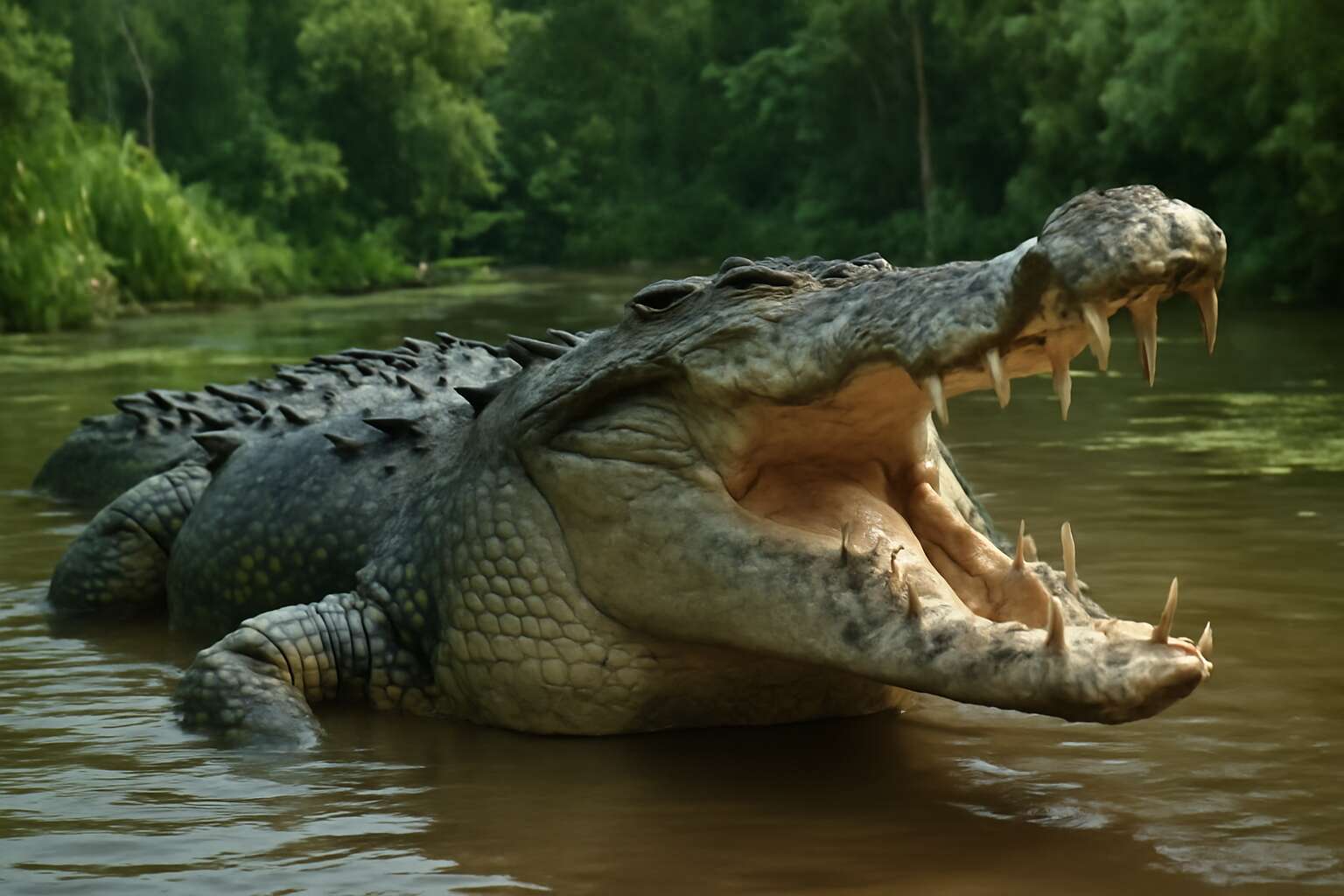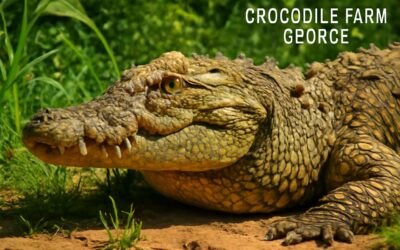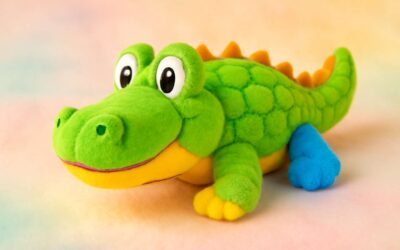Overview of Crocodile Species
Introduction to Crocodiles – Brief overview of crocodiles and their significance in ecosystems
Crocodiles have long been symbols of ancient power and resilience, playing crucial roles in their ecosystems as apex predators. Their presence helps maintain the balance of aquatic and terrestrial habitats, preventing overpopulation of prey species and supporting biodiversity. Among the various crocodile species, some are renowned for their impressive size, raising the question: which crocodile is the biggest?
Understanding the diversity of crocodile species reveals fascinating differences in their morphology and ecological niches. While the saltwater crocodile (Crocodylus porosus) often steals headlines due to its enormous stature, other species like the Nile crocodile (Crocodylus niloticus) also grow remarkably large. The size of these predators isn’t just a matter of curiosity; it reflects their evolutionary success and adaptability. In fact, the saltwater crocodile holds the record as the largest living crocodile, reaching lengths of over 7 metres and weights exceeding a tonne.
So, when exploring which crocodile is the biggest, it’s essential to consider both maximum attainable size and geographic distribution. The saltwater crocodile’s ability to thrive across vast coastal regions makes it a formidable contender in the size stakes, but other species like the Orinoco crocodile are notable for their size and conservation status.
Major Crocodile Species – List of main crocodile species including Nile, Saltwater, Mugger, and Morelet’s crocodiles
The world of crocodiles is as diverse as it is awe-inspiring, with several species exhibiting remarkable sizes and adaptations. Each species occupies a unique ecological niche, but among them, a few stand out for their impressive stature. The Nile crocodile, for example, is renowned for its formidable presence in Africa’s freshwater systems, often reaching lengths of up to 5.5 metres. Meanwhile, the Mugger crocodile (Crocodylus palustris) is more modest in size but still commands respect in its habitat. However, when exploring which crocodile is the biggest, the spotlight inevitably falls on the saltwater crocodile.
As the largest living crocodile species, the saltwater crocodile (Crocodylus porosus) can surpass all others in sheer size. These apex predators are capable of reaching astonishing lengths of over 7 metres, with weights exceeding a tonne. Their expansive range across coastal regions of Australia, Southeast Asia, and the Indian subcontinent underscores their remarkable adaptability. Other notable species include the Morelet’s crocodile and the Orinoco crocodile, which, although impressive in their own right, do not rival the sheer size of the saltwater crocodile.
Understanding these species’ differences provides a fascinating glimpse into the evolutionary pressures that sculpted their formidable forms. For those curious about which crocodile is the biggest, the answer is clear: the saltwater crocodile reigns supreme, a true giant of the reptile world. Its dominance in size is matched only by its resilience and adaptability across diverse aquatic environments.
Comparing Crocodile Sizes and Dimensions
Average Size of Different Crocodile Species – Details on typical length and weight of various species
When pondering which crocodile is the biggest, size becomes a fascinating measure of both nature’s grandeur and survival mastery. The average size of different crocodile species varies dramatically, revealing their adaptive strategies and ecological niches. For instance, the saltwater crocodile, often celebrated as the largest of all crocodiles, can reach remarkable lengths that leave many in awe.
Typically, adult saltwater crocodiles grow between 4.3 to 5.2 metres in length, with some exceptional specimens surpassing 6 metres. Their weight can soar past 1,000 kilograms, making them formidable predators and true giants of freshwater and marine environments. By comparison, Nile crocodiles tend to measure up to 4.2 metres on average, with weights around 730 kilograms, while Mugger crocodiles are slightly smaller, averaging around 3.5 metres.
Understanding these size disparities is crucial for grasping which crocodile is the biggest. The saltwater crocodile’s impressive dimensions solidify its reputation as the largest crocodilian species, a testament to its evolutionary prowess. Such comparisons highlight not only their physical dominance but also their importance within their respective ecosystems, where size often correlates with survival and predatory success.
Largest Recorded Crocodiles – Examples of the biggest specimens of each species
When contemplating the question of which crocodile is the biggest, the answer is as impressive as it is varied. The saltwater crocodile, a true titan among reptiles, regularly claims the title with specimens exceeding 6 metres in length and tipping the scales at over 1,000 kilograms. These giants dominate both freshwater and marine ecosystems, demonstrating nature’s remarkable capacity for size and adaptability.
For context, the largest recorded saltwater crocodile, named Lolong, was officially measured at an astonishing 6.17 metres. Such specimens are rare but serve as living proof that the saltwater crocodile holds the crown for the largest crocodile species. In comparison, Nile crocodiles, while formidable, seldom surpass 4.2 metres in the wild, with the largest recorded reaching just over 5 metres. Mugger crocodiles are notably smaller, averaging around 3.5 metres, yet still commanding respect in their habitats.
To better appreciate these colossal creatures, consider this list of the biggest specimens:
- Saltwater crocodile: Over 6 metres (Lolong, 6.17 metres)
- Nile crocodile: Up to 5 metres (Lolong, 5.34 metres)
- Mugger crocodile: Approximately 3.5 metres
Such extraordinary sizes not only highlight which crocodile is the biggest but also underscore their evolutionary mastery and ecological dominance. These behemoths continue to fascinate scientists and nature enthusiasts alike, standing as testaments to the grandeur and resilience of crocodilian species.
Factors Influencing Crocodile Size – Habitat, diet, genetics, and environmental conditions
Understanding which crocodile is the biggest involves more than just measuring length; it requires examining a complex interplay of factors that influence size. Habitat, for instance, plays a crucial role—saltwater crocodiles thrive in brackish and marine environments, allowing them to achieve extraordinary dimensions. Diet is equally pivotal; a diet rich in large prey provides the necessary sustenance for growth beyond typical limits. Genetics, of course, lays the foundation—certain lineages are predisposed to larger sizes, passing down genes that favour increased stature. Environmental conditions, such as climate and availability of resources, further shape these formidable reptiles, enabling some specimens to grow beyond expectations.
For those curious about which crocodile is the biggest, it’s essential to consider these factors collectively. Among the most impressive are the saltwater crocodiles, which regularly surpass 6 metres in length. Their evolutionary mastery over size is a testament to nature’s grandeur and resilience, making them the undisputed giants in the world of crocodilians. Ultimately, the question of which crocodile is the biggest remains a fascinating mosaic woven through the threads of biology, environment, and sheer evolutionary mastery.
The Biggest Crocodile Species
Saltwater Crocodile (Crocodylus porosus) – Overview and evidence of maximum size
When pondering which crocodile is the biggest, the Saltwater Crocodile (Crocodylus porosus) takes the crown with impressive élan. These aquatic giants can reach lengths of up to 7 metres (23 feet), making them the largest living reptiles on the planet. Believe it or not, some specimens have weighed over a staggering 1,000 kilograms (2,200 pounds), showcasing their formidable size and power. Their sprawling habitats stretch from the eastern Indian Ocean through Southeast Asia to northern Australia, where they reign supreme in coastal and riverine ecosystems.
What makes the Saltwater Crocodile’s size even more extraordinary is the evidence of some extraordinary specimens. The largest recorded saltwater crocodile, named Lolong, measured an astonishing 6.17 metres (20.2 feet) and was officially recognised as the biggest crocodile ever captured and measured. This colossal creature exemplifies the remarkable potential of which crocodile is the biggest, solidifying their reputation as apex predators. Factors like habitat, diet, and genetics all contribute to their awe-inspiring size, but there’s no denying that the Saltwater Crocodile remains the ultimate heavyweight champion among crocodilian species.
Nile Crocodile (Crocodylus niloticus) – Comparison to other large crocodiles
While the Saltwater Crocodile often steals the limelight with its colossal size, the Nile Crocodile (Crocodylus niloticus) also deserves recognition as one of the largest crocodile species. Known for their formidable presence in African waterways, Nile crocodiles can reach lengths of up to 5.5 metres (18 feet), with some exceptional specimens approaching 6 metres. Although slightly smaller than their saltwater cousins, they are equally efficient apex predators, thriving in diverse aquatic habitats ranging from lakes to rivers.
When comparing which crocodile is the biggest, the Nile Crocodile holds its own, exhibiting impressive dimensions that rival other large species. For instance, the largest recorded Nile crocodile measured an astonishing 5.88 metres (19.3 feet), a testament to their potential for remarkable growth. Their broad snouts and powerful limbs make them stand out, yet it is their adaptability across the African continent that truly cements their status in the crocodilian hierarchy.
Further, it’s fascinating to note that:
- While the Nile crocodile can attain significant sizes, it generally does not surpass the maximum lengths of the Saltwater Crocodile.
- Environmental factors such as habitat quality and available prey influence their growth potential.
- Genetics and diet play pivotal roles in determining the ultimate size of these formidable reptiles.
Ultimately, although the Nile crocodile is not the largest crocodile species in terms of maximum size, its reputation as a giant among freshwater crocodiles remains undisputed. When pondering which crocodile is the biggest, the Nile crocodile’s impressive size and widespread distribution make it a key contender in the ongoing debate among crocodilian giants.
Other Notably Large Crocodiles – Additional species that can reach impressive sizes
While the Nile crocodile (Crocodylus niloticus) often claims the spotlight among large crocodiles, other species rival and sometimes surpass its size. The Saltwater crocodile (Crocodylus porosus), for instance, holds the record for the largest crocodile ever documented, with specimens exceeding 6 metres (19.7 feet)! This formidable predator’s immense girth and length make it the undisputed heavyweight champion in the crocodilian world.
However, when considering which crocodile is the biggest, it’s essential to explore other notable contenders. The Mugger crocodile (Crocodylus palustris), primarily found across the Indian subcontinent, can reach lengths of up to 4.3 metres (14 feet). Similarly, the Morelet’s crocodile (Crocodylus moreletii), native to Central America, can grow to about 3.5 metres (11.5 feet), yet occasionally larger specimens surface in the wild.
- Saltwater crocodile – up to 6.2 metres (20.3 feet)
- Nile crocodile – up to 5.88 metres (19.3 feet)
- Mugger crocodile – up to 4.3 metres (14 feet)
- Morelet’s crocodile – up to 3.5 metres (11.5 feet)
Environmental factors, prey availability, and genetic predispositions significantly influence these giants’ maximum size. Despite the Nile crocodile’s impressive stature, the Saltwater crocodile’s sheer size and power elevate it to the top of the hierarchy when asking which crocodile is the biggest. The battle of the giants continues, but one thing remains clear: size is a defining trait among the most awe-inspiring creatures in the reptilian kingdom.
Record-Holding Crocodiles
World Records for Largest Crocodile – Details of record-holding specimens
When pondering the question of which crocodile is the biggest, one cannot ignore the astonishing records set by the saltwater crocodile (Crocodylus porosus). This formidable species holds the crown for the largest living crocodile, with specimens exceeding 6 metres (20 feet) in length—an awe-inspiring sight if ever there was one! The record for the largest saltwater crocodile ever caught was a staggering 17 feet 9 inches (5.43 metres), discovered in the Northern Territory of Australia. These colossal creatures not only command respect but also demonstrate the incredible diversity of size among crocodile species.
Interestingly, the Nile crocodile (Crocodylus niloticus) also boasts impressive dimensions, with the largest confirmed specimen reaching just over 5.5 metres (18 feet). While slightly smaller than the saltwater crocodile, Nile crocodiles are renowned for their robust build and predatory prowess. Other notable contenders include the Mugger and Morelet’s crocodile, but they generally do not rival the sheer size of their larger cousins. Ultimately, the question of which crocodile is the biggest is answered by the saltwater crocodile—an apex predator that continues to enthral scientists and enthusiasts alike with its astonishing size and resilience.
Notable Crocodile Size Records by Region – Largest crocodiles found in different parts of the world
Across the vast, shimmering waterways of the world, certain crocodiles have etched their names into the annals of natural marvels. When asking which crocodile is the biggest, the answer invariably points to the saltwater crocodile (Crocodylus porosus). These formidable giants have been documented reaching astonishing lengths—over 6 metres, with some specimens exceeding 17 feet 9 inches (5.43 metres). Such colossal creatures are often seen lurking in the northern waters of Australia, where the record-breaking saltwater crocodile continues to captivate both scientists and adventurers alike.
Regionally, notable crocodiles have set remarkable size records. In Africa, the Nile crocodile (Crocodylus niloticus) has produced specimens just over 5.5 metres (18 feet), showcasing its impressive, stocky build. Meanwhile, in Asia, the Mugger and Morelet’s crocodiles tend to be slightly smaller, yet they still command awe with their robust frames. The largest crocodiles often emerge from habitats that provide abundant food sources, warm climates, and ample space for growth. These environmental factors play a pivotal role in shaping which crocodile is the biggest, allowing certain species to grow to their awe-inspiring maximum sizes.
- Saltwater Crocodile (Crocodylus porosus)
- Nile Crocodile (Crocodylus niloticus)
- Mugger Crocodile (Crocodylus palustris)
- Morelet’s Crocodile (Crocodylus moreletii)
Among these, the saltwater crocodile undeniably claims the title of the largest crocodile in the world. Its extraordinary size, resilience, and predatory prowess make it an apex predator that commands respect across its range. Whether in the murky waters of the Nile or the coastal estuaries of Australia, the question of which crocodile is the biggest continues to fuel fascination and admiration—testament to nature’s grandeur and the relentless pursuit of survival.
Habitat and Geographic Distribution
Regions Hosting the Biggest Crocodiles – Africa, Australia, Southeast Asia, and other regions
Across the sprawling tapestry of our planet’s waterways, certain regions cradle the giants of the crocodile world. The habitat and geographic distribution of these formidable reptiles are as diverse as their sizes are astonishing. In Africa, the Nile crocodile reigns supreme, lurking along the Nile River and its tributaries—its formidable presence a testament to the continent’s wild, untamed wilderness. Meanwhile, in the sun-baked waters of Australia, the saltwater crocodile, often dubbed the “saltie,” claims the title of the largest crocodile species, stretching over vast coastal regions and estuaries.
Southeast Asia offers its own sanctuary for sizeable crocodiles, with species like the mugger and Morelet’s crocodiles thriving in freshwater habitats. Some regions, especially northern Australia and parts of West Africa, are renowned for hosting the largest crocodiles in the world. These areas create an environment where genetics, abundant prey, and favourable environmental conditions foster the growth of these prehistoric titans. Interestingly, the largest recorded crocodiles of each species often emerge from these regions, sparking curiosity about which crocodile is the biggest and where it might be lurking right now!
Habitat Characteristics Favoring Larger Crocodiles – Environmental factors contributing to size
In the shadowed depths of remote waterways, the environment plays a pivotal role in nurturing the giants of the crocodile world. These formidable creatures thrive in habitats that offer abundant prey, warm waters, and shelter, creating an ideal stage for extraordinary growth. Regions such as northern Australia and parts of West Africa are renowned for fostering the largest crocodiles, providing a natural sanctuary where genetics and environment intertwine to produce these prehistoric titans.
Favourable environmental factors—such as consistent warm temperatures, ample food sources, and minimal human interference—are critical in allowing crocodiles to reach their maximum size. In these regions, crocodiles often grow larger than their counterparts elsewhere. The habitat characteristics that promote such growth include expansive estuaries, river systems with rich biodiversity, and coastal waters that offer an endless buffet of sustenance.
Interestingly, the combination of these elements results in a natural selection for size, where the largest specimens—like the infamous saltwater crocodile—can attain remarkable lengths. These factors collectively cultivate an environment where the question of which crocodile is the biggest becomes not just a matter of genetics but an intricate dance with nature itself.
Conservation and Ethical Considerations
Impact of Human Activities on Crocodile Sizes – Habitat loss, poaching, and conservation efforts
In the shadowed depths of the world’s waterways, the question of which crocodile is the biggest sparks fascination among explorers and scientists alike. Human activities have cast a long, often destructive, shadow over these ancient predators. Habitat loss driven by urbanisation, agriculture, and industrial expansion diminishes the natural sanctuary where these formidable creatures once thrived. Poaching for their valuable skins and trophies further threatens their existence, pushing many species towards the brink of decline.
Despite these challenges, conservation efforts continue to make a difference. Protected areas, breeding programmes, and international legislation aim to safeguard the largest crocodile species. These initiatives not only preserve iconic specimens but also ensure the ecological balance of their habitats. It is essential to recognise that the survival and growth of these majestic reptiles depend heavily on our collective effort to reduce human impact. Only through dedicated conservation can we hope to witness future generations pondering which crocodile is the biggest in the centuries to come.
Protecting the Largest Crocodiles – Importance of conservation for large, vulnerable species
In the mysterious depths of the world’s waterways, the question of which crocodile is the biggest continues to captivate explorers and scientists alike. These formidable predators, steeped in myth and legend, have long fascinated us with their immense size and ancient presence. Protecting these colossal creatures is not only a matter of ecological significance but a moral obligation; their survival hinges on our commitment to conservation efforts. Large, vulnerable species such as the saltwater crocodile and Nile crocodile face relentless threats from habitat destruction and poaching.
Conservation initiatives play a vital role in safeguarding these giants. Efforts include strict legislation, habitat preservation, and breeding programmes designed to bolster dwindling populations. Recognising the importance of ethical considerations, many organisations now emphasise sustainable practices that prevent exploitation and ensure the well-being of these majestic reptiles. It is crucial that we continue to support and expand these initiatives, for only then can we preserve the ancestral wonder of which crocodile is the biggest, ensuring future generations can marvel at their awe-inspiring grandeur.




0 Comments